The Philippines declared Martial Law on September 23, 1972. This event started a 14-year rule by President Ferdinand Marcos. It deeply changed the country’s politics, economy, and society. To learn more, visit Philippine History and explore Martial Law’s complexities.
The economy suffered a lot during Martial Law. Foreign debt rose from $278 million in 1965 to over $25 billion by 1986. It took 21 years to get back to 1982’s GDP level. Martial Law hurt many, with thousands arrested and 3,240 killed from 1972 to 1981.
Key Takeaways
- The declaration of Martial Law in the Philippines was announced on September 23, 1972, at 7:17 p.m.
- Approximately 34,000 individuals reported being tortured during the Martial Law period.
- Around 70,000 people were imprisoned under Martial Law, with over 1,600 individuals disappearing, never to be found.
- The Philippine economy was severely impacted, with a 26% average wage decrease for skilled and unskilled workers.
- The legacy of Martial Law continues to influence Philippine History, with ongoing efforts to recover stolen assets and provide justice for victims of human rights violations.
- The events surrounding Martial Law highlight the importance of civil liberties and democratic values in Philippine History.
- The People Power Revolution in 1986 marked a significant turning point in Philippine History, ending the Marcos dictatorship and inspiring global movements for democracy and social change.
The Political Climate Before Martial Law
In the 1960s, the Philippines was struggling with its Philippine Democracy. The system was young and faced issues like corruption, inequality, and poor representation for the less fortunate. This led to Social Unrest as people demanded better lives, jobs, and fairness.
The country also faced Economic Challenges like a big trade deficit, high inflation, and little foreign investment. These problems made life harder for many Filipinos, adding to the Social Unrest.
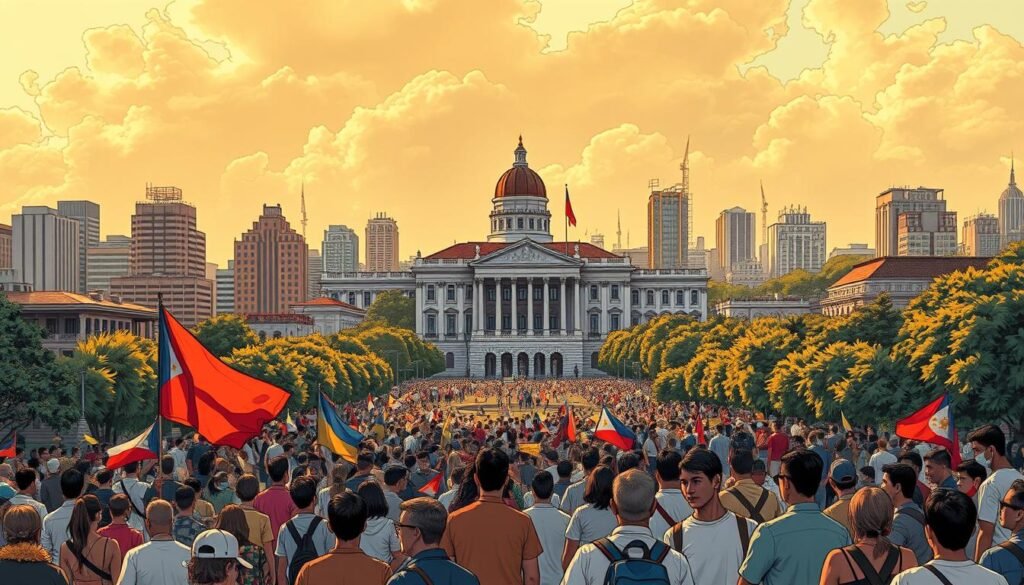
- Corruption and inequality
- Lack of representation for the poor and marginalized
- Large trade deficit and high inflation
- Lack of foreign investment
These problems created a tense political atmosphere. This tension would eventually lead to Martial Law in 1972. It would greatly affect the Philippine Democracy and the lives of Filipinos for many years.
Ferdinand Marcos’s Rise to Power
Ferdinand Marcos was a charismatic and ambitious politician who rose to power in the 1960s. He was born in 1917 in the province of Ilocos Norte. He studied law at the University of the Philippines.
Marcos entered politics in the 1940s and quickly rose through the ranks. He became a member of the House of Representatives and later a senator.
In 1965, he was elected president of the Philippines. He promised to bring about economic development, social justice, and greater democracy. His campaign highlighted his alleged war hero status, which greatly appealed to the public. As president, Ferdinand Marcos played a crucial role in shaping Philippine Politics, leaving a lasting impact on the country.
Some key points about Ferdinand Marcos’s rise to power include:
- He was elected president in 1965 with a significant public appeal
- His campaign emphasized his alleged war hero status
- He promised to bring about economic development, social justice, and greater democracy to the country
As the 10th President of the Philippines, Ferdinand Marcos’s administration had a profound impact. His rule, from 1965 to 1986, was marked by both initial economic growth and eventual collapse. This led to widespread poverty and human rights abuses.
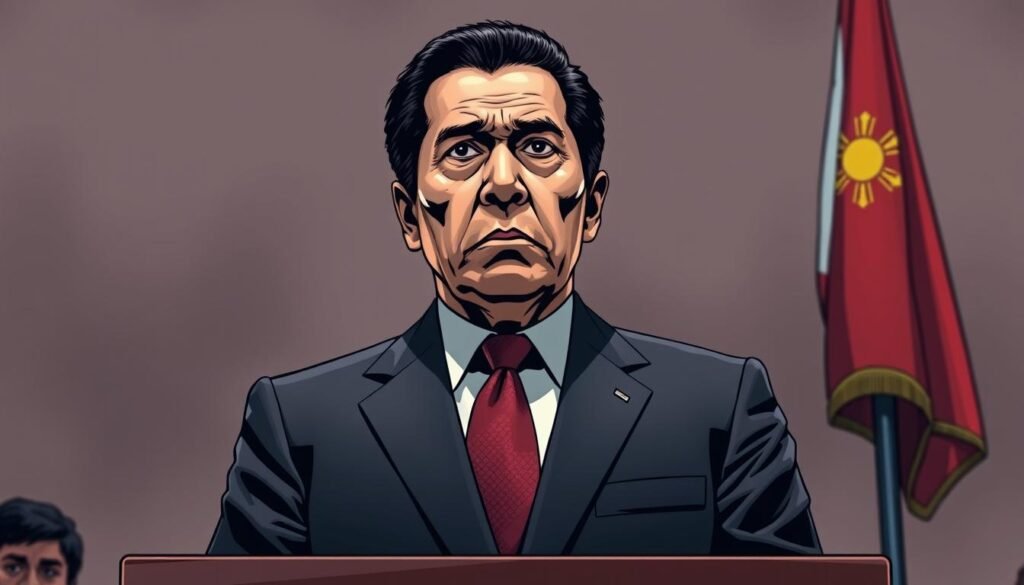
The Declaration of Martial Law in the Philippines
The Philippines saw a major shift when President Ferdinand Marcos declared Martial Law on September 21, 1972. He issued Proclamation 1081, citing the growing communist threat and the need for order. This move had a huge impact on the country.
People reacted differently to Martial Law. Some supported it, while others opposed it. The Military Implementation of Martial Law was quick and firm. The army and police took control, arresting many opposition leaders and activists.
Some important facts about Martial Law in the Philippines are:
- It lasted from 1972 to 1981, nearly a decade.
- Tens of thousands were arrested, detained, and tortured.
- Many executions took place, including Benigno Aquino Jr.
Martial Law had a big impact on the Philippines. It led to a time of human rights abuses and silenced opposition. The Proclamation 1081 and the Military Implementation of Martial Law changed the country’s history and politics for many years.
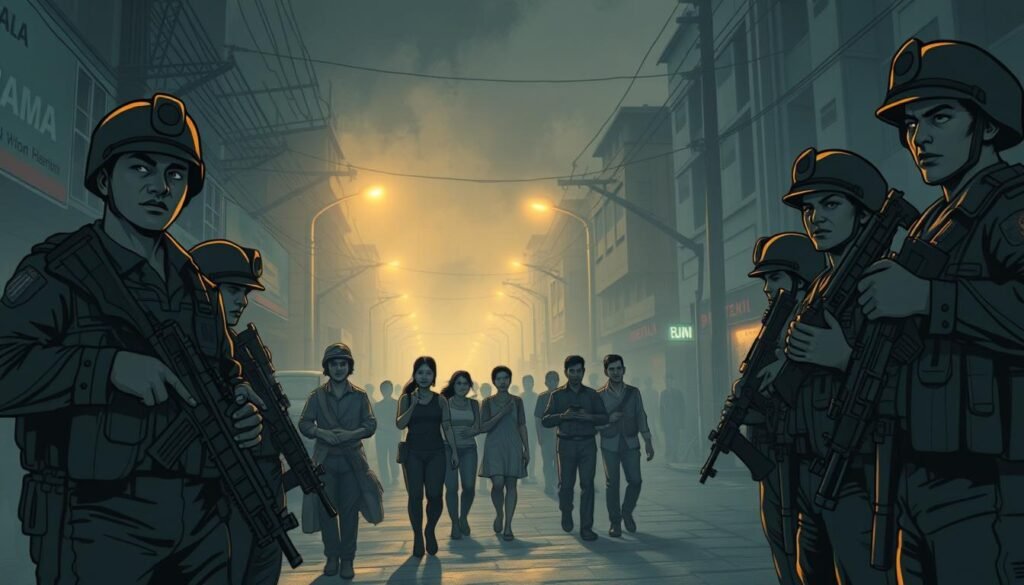
Legal Framework and Constitutional Changes
The Philippines declared Martial Law, leading to big Legal Framework and Constitutional Changes. These changes aimed to give more power to the government and reduce citizens’ rights. The 1935 Constitution was replaced by a new one in 1973, making the president more powerful.
The Constitutional Changes also made the military and police stronger. They could arrest and detain people more easily. This was meant to keep order but also led to human rights issues.
The table below shows the main Constitutional Changes and their effects on the Legal Framework:
| Constitutional Change | Impact on Legal Framework |
|---|---|
| Replacement of 1935 Constitution | Increased presidential powers, limited legislature and judiciary |
| Introduction of new laws and decrees | Greater powers for military and police to arrest and detain citizens |
These Constitutional Changes and the new Legal Framework greatly affected the country. They led to a time of authoritarian rule and human rights abuses. Knowing about these changes helps us understand the Martial Law period in the Philippines better.
The New Society Movement
The New Society Movement started in 1978. It was a campaign by Ferdinand Marcos to show his vision for a modern Philippines. The movement aimed for a society that was equal, just, and self-reliant.
It promised a better life for all, economic growth, and care for the environment. The movement’s goals were to make the Philippines a better place.
The movement had mixed reactions from the public. Some people supported it, while others did not. Despite this, the New Society Movement had a big impact on the Philippines.
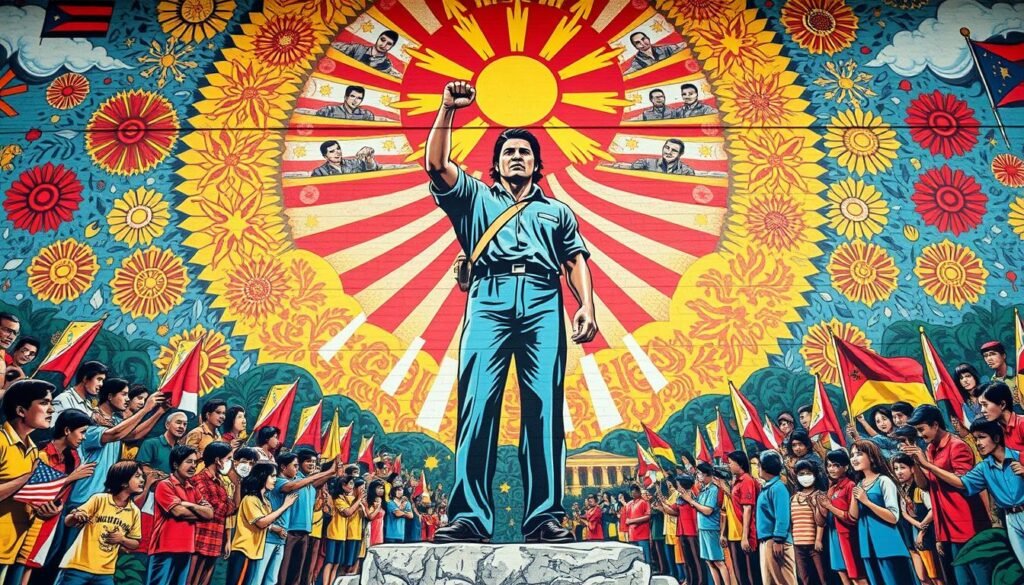
The movement’s legacy is still felt today. It continues to influence politics in the Philippines. Many politicians use its ideas to shape their policies.
As the Philippines moves forward, the New Society Movement is a key part of its history. It shows how important public opinion is in shaping the country’s future.
Economic Policies During the Martial Law Era
The Martial Law Era in the Philippines saw big steps in economic policies. The government worked on projects like building roads, boosting tourism, and starting new industries. These included making things and growing food.
One big win was when the Philippines started exporting rice by the late 1970s. This was thanks to better irrigation and new rice types. But, the era also faced tough times. These included a big trade deficit, high prices, and not enough foreign money coming in.
The Marcos regime saw GDP grow by almost 6% yearly from 1972 to 1980. But, the country hit a hard recession in 1984 and 1985. GDP fell by 7.3% for two years in a row. The Martial Law Era’s economic plans left a lasting mark. It took the Philippines over 20 years to get back to the 1982 GDP level.
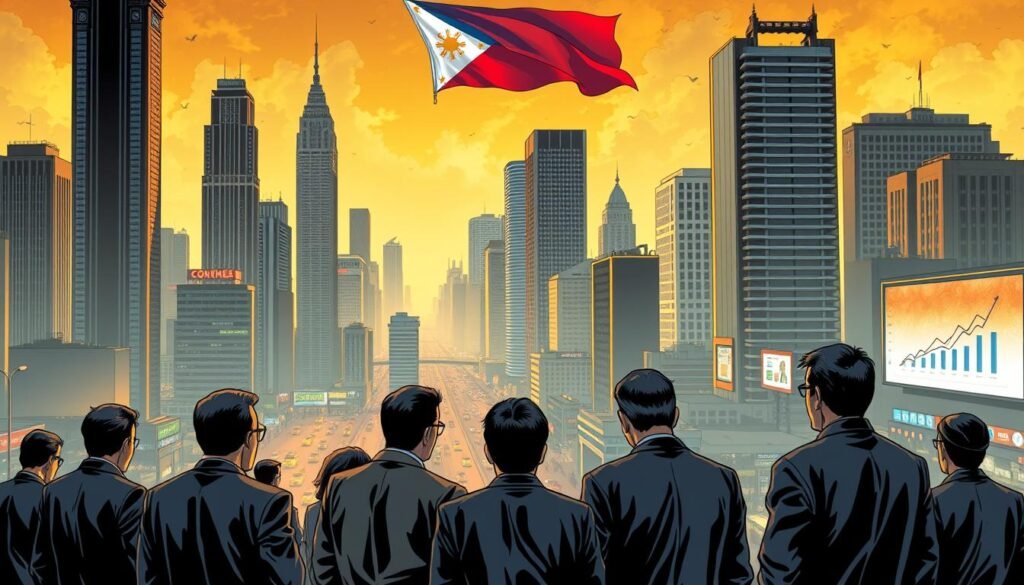
The Martial Law Era’s economic plans aimed to boost growth and start new industries. While there was some growth, the era faced big challenges. These included a growing trade deficit and high inflation. Knowing about these economic policies helps us understand the Philippines’ economic history.
Human Rights Violations and Political Persecution
The Martial Law era in the Philippines saw many Human Rights Violations and Political Persecution. Thousands of opposition leaders and activists were arrested, detained, and tortured. This had a big impact on Civil Society.
There were 3,257 known extrajudicial killings, 35,000 documented cases of torture, and 737 reported disappearances. The international community condemned the Marcos regime. Many countries imposed economic sanctions.
The Political Persecution had a lasting effect on Civil Society. Many Filipinos lost faith in the government and the political system. Here are some documented cases of human rights violations during Martial Law:
| Year | Incident | Number of Victims |
|---|---|---|
| 1981 | Guinayangan massacre | 2 fatalities, 27 injuries |
| 1981 | Tudela massacre | 10 fatalities |
| 1981 | Las Navas massacre | 45 fatalities |
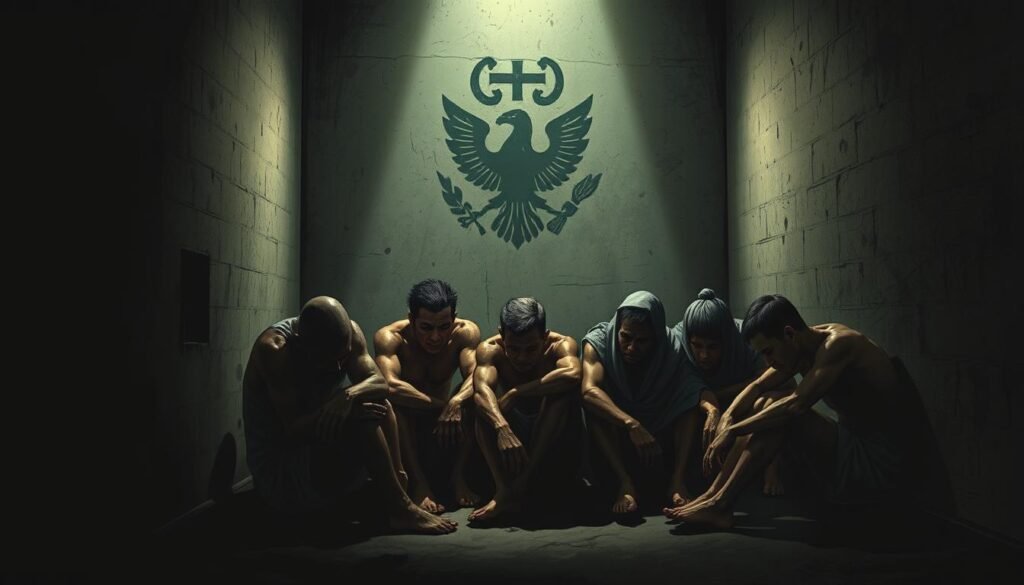
The legacy of Human Rights Violations and Political Persecution during Martial Law still affects Civil Society in the Philippines today.
Media Control and Propaganda
The Marcos regime had a tight grip on the media in the Philippines during Martial Law. They shut down many media outlets, like 7 TV stations, 16 daily newspapers, and 292 radio stations. They also ran Propaganda campaigns to push their views and policies.
They made a rule that news had to be “positive national value” only. This meant no critical journalism was allowed. The government also set up the Media Advisory Council (MAC). It required media to get a special permit, which Marcos had to approve.
This Propaganda misled many Filipinos about their country. The regime arrested and tortured many journalists. The Philippine Movement for Press Freedom says 34 journalists were killed during Marcos’ rule.
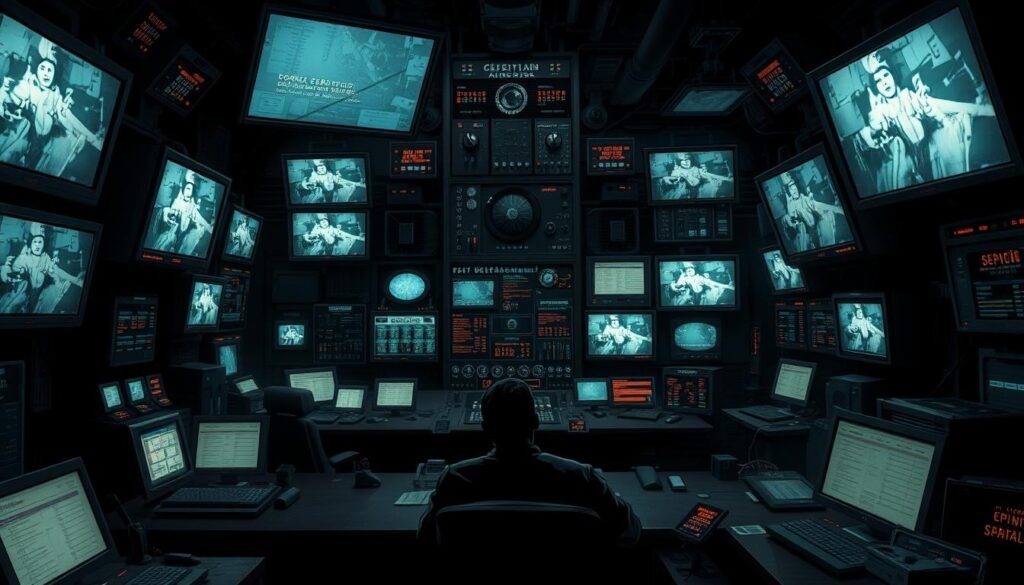
The regime used Propaganda to silence opposition and show Marcos as a strong leader. But, the impact of this Media Control and Propaganda is still felt today. Many Filipinos are still searching for truth and justice from the Martial Law era.
The Role of the Military During Martial Law
The military was very important during Martial Law in the Philippines. Many military officers got important government jobs. President Ferdinand Marcos controlled the military directly. This changed how people saw the military and the government.
The Military focused on stopping anyone who disagreed with the government. Sadly, many military officers broke human rights. This made people lose trust in the military and the government.
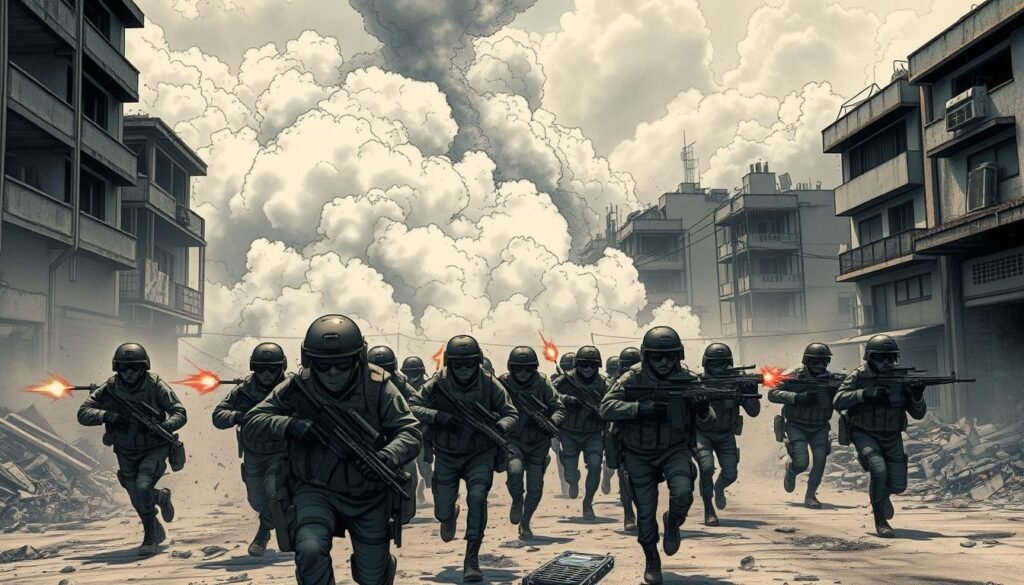
Some key points about the military’s role during Martial Law are:
* Centralized Chain of Command
* Suppression of opposition and dissent
* Human rights violations
* Impact on Civil-Military Relations
Opposition Movement and Underground Resistance
The opposition movement in the Philippines during Martial Law was complex. Many groups and individuals fought against the Marcos regime. The Underground Resistance was key, with Filipinos engaging in secret sabotage and guerrilla warfare.
The First Quarter Storm in 1970 was a major wave of protests. It started due to a 1969 economic crisis, causing widespread hardship. Groups from all sides joined, wanting to end Marcos’s rule.
As Marcos’s control grew, the opposition went underground. Activists and artists used their work to resist. “Bayan Ko” became a symbol of resistance, inspiring many to join the fight.
The opposition and underground resistance were crucial in ending Marcos’s rule. Their bravery led to the 1986 People Power Revolution. Today, their legacy motivates Filipinos for a fair society. The Opposition Movement and Underground Resistance remind us of the need to stand up against oppression.
International Relations During the Period
The Philippines was important in International Relations during Martial Law. Its U.S.-Philippine Relations were very close. The U.S. gave a lot of economic and military help to the Marcos regime.
This close relationship helped shape the Philippines’ role in Regional Dynamics. The country was part of ASEAN and played a big part in regional affairs.
Historical documents, like those on the U.S. Department of State website, show how the Philippines’ international relations were shaped. Its location and economic interests played a big role. Being part of ASEAN helped promote Regional Dynamics and cooperation.
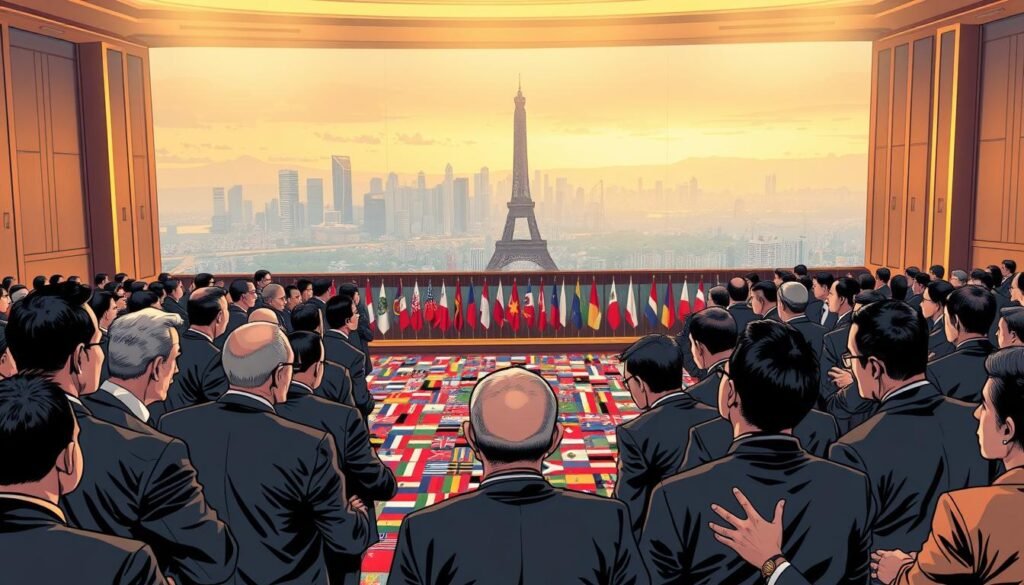
The Philippines’ International Relations during Martial Law were complex. Key points include:
* Being part of ASEAN
* A close relationship with the U.S., including aid
* Growing trade with countries like the European Economic Community and the Soviet Union
* Human rights concerns and international criticism of the Marcos regime
The Economic Legacy of Martial Law
The Economic Legacy of Martial Law in the Philippines is complex. The Marcos regime started many development projects. These included new infrastructure, tourism promotion, and new industries like manufacturing and agriculture.
But, these policies also caused a trade deficit, high inflation, and less foreign investment. Economic experts say the GDP grew by 3.4% annually from 1972 to 1985. Per capita GDP grew by just 0.82% during the same time.
Some key statistics show the lasting impact of Martial Law on the economy:
- Average GDP growth from 2003 to 2014 was 5.4% per annum, much higher than during Martial Law.
- Today, per capita GDP grows by 3.5% annually, over four times the rate under Martial Law.
- Total debt in the Philippines in 1977 was $8.2 billion, rising to $24.4 billion by 1982.
The Economic Legacy of Martial Law still affects the Philippines today. The era was plagued by corruption and cronyism. This concentrated wealth and power among a few.
The Philippines was seen as the ‘sick man of Asia’ after the Marcos dictatorship. This shows the severe economic challenges the country still faces.
Cultural Changes and Social Impact
The declaration of Martial Law in 1972 changed the Philippines a lot. The Marcos regime brought in new policies to change culture and society. The Education System was one of the main areas affected.
The Education System was changed to focus more on nationalism and patriotism. This meant teaching more about Philippine history and culture. This change deeply influenced the younger generation’s values and beliefs.
During this time, the arts and literature also saw big changes. Many artists and writers faced censorship or persecution.
The table below shows some key Cultural Changes and Social Impact of Martial Law:
| Area of Change | Description |
|---|---|
| Education System | Greater emphasis on nationalism and patriotism |
| Arts and Literature | Censorship and persecution of artists and writers |
| Social Values | Promotion of obedience and loyalty to the government |
The Cultural Changes and Social Impact of Martial Law have lasted long in the Philippines. They have shaped the country’s values and beliefs for many years.
The People Power Revolution’s Role in Ending Martial Law
The People Power Revolution was a key moment in Philippine history. It ended Martial Law and brought back democracy. Over 2,000,000 people joined the revolution from February 22 to 25, 1986. They called for an end to the Marcos regime.
The revolution was the result of years of protests against Marcos. These protests were due to human rights abuses and economic troubles. By the end of 1983, the Philippine economy had shrunk by 6.8%, hitting its worst recession ever.
Key events that led to the People Power Revolution include:
- The assassination of Ninoy Aquino on August 21, 1983, which sparked more protests against Marcos.
- The snap elections on February 7, 1986, were disputed due to election tampering claims.
- The walkout of 50 opposition Members of Parliament on February 15, 1986, in protest of Marcos’s election win.
The People Power Revolution was vital in Ending Martial Law and restoring democracy in the Philippines. It showed that people’s power can change things. It proved that together, citizens can bring down an authoritarian regime.
Modern Day Perspectives on Martial Law
The legacy of martial law in the Philippines is still talked about today. Many Filipinos think about the Modern Day Perspectives of this time. It’s important to tackle Historical Revisionism and its effects on the nation’s view of its past.
The martial law era deeply affected the education system. This has led to ongoing Educational Challenges that are still felt today.
Reports show that over 3,000 people were killed during martial law. About 35,000 were tortured, and around 70,000 were jailed. These numbers show why we need true historical accounts and education on this time. The Contemporary Political Impact of martial law is also big, with many politicians and policymakers still influenced by Marcos’ ideas.
Some important facts about martial law include:
- More than 3,000 individuals were killed
- Approximately 35,000 people were reported to have been tortured
- An estimated 70,000 individuals were incarcerated
These numbers show the harsh human rights violations of that time. They highlight the need to address Historical Revisionism and Educational Challenges. This ensures a true understanding of the Philippines’ history.
Conclusion
The Martial Law era in the Philippines started on September 21, 1972. Ferdinand Marcos signed Proclamation No. 1081. This period had a big impact on the country’s history.
It was marked by human rights abuses, political repression, and economic challenges. To learn more, you can visit the Martial Law in the Philippines page. It gives a detailed overview of this era.
The legacy of Martial Law is still felt today. Many Filipinos debate its impact on society. The end of Martial Law was a big turning point for the country.
It moved from authoritarianism to democracy. The Philippines is still facing challenges like economic development and social justice. But, the country has made a lot of progress since then.
In conclusion, Martial Law was a complex and tumultuous time in Philippine history. It had far-reaching consequences for the country and its people. Understanding this period is key to grasping the complexities of Philippine society and politics today.
FAQ
What was the Declaration of Martial Law in the Philippines?
The Declaration of Martial Law in the Philippines was a key event in the country’s history. It was declared by President Ferdinand Marcos on September 23, 1972. This marked the start of a 14-year period of authoritarian rule.
What were the reasons behind the declaration of Martial Law?
Marcos said Martial Law was needed to fight the growing communist insurgency and keep law and order. But many saw it as a power grab by Marcos.
What was the state of Philippine democracy in the 1960s?
In the 1960s, Philippine democracy was still young and faced many challenges. These included corruption, inequality, and a lack of voice for the poor and marginalized.
Who was Ferdinand Marcos and how did he rise to power?
Ferdinand Marcos was a charismatic politician who rose to power in the 1960s. He became a member of the House of Representatives and then a senator. He was elected president of the Philippines in 1965.
What was Proclamation 1081 and what did it signify?
Proclamation 1081 was a key document signed by Marcos on September 21, 1972. It declared Martial Law, citing the communist insurgency and the need for law and order.
How did the military implement Martial Law?
The military quickly took control when Martial Law was declared. They arrested opposition leaders and activists, and took over key installations.
What were the key features of the New Society Movement launched by Marcos?
Marcos launched the New Society Movement to promote a modern Philippines. It was based on nationalism, self-reliance, and social justice.
What were the economic policies during the Martial Law era?
During Martial Law, Marcos focused on economic development. He aimed to create new industries, but this led to a trade deficit, high inflation, and low foreign investment.
What were the human rights violations and political persecution during the Martial Law era?
Martial Law was marked by human rights abuses and political persecution. Thousands were arrested, tortured, and killed by the military and police.
How did the international community respond to the human rights violations during the Martial Law era?
The world condemned Marcos’ regime for human rights abuses. Many countries imposed economic sanctions, criticizing the regime’s authoritarianism and human rights record.
What was the role of the military during the Martial Law era?
The military played a big role during Martial Law. Many officers held key government positions and were involved in human rights abuses and political persecution.
What was the impact of Martial Law on Philippine society and economy?
Martial Law had a big impact on the Philippines. Democracy, human rights, and economic development declined. Poverty, inequality, and unrest increased.
How did the People Power Revolution contribute to the end of Martial Law?
The People Power Revolution was crucial in ending Martial Law. Millions of Filipinos protested in the streets, demanding democracy and an end to the Marcos regime.
What are the modern-day perspectives on Martial Law in the Philippines?
Views on Martial Law in the Philippines today are complex. Many debate the Marcos regime’s legacy and its impact on history and society. Issues like historical revisionism, education, and politics remain relevant.
Source Links
- Why Did Marcos Declare Martial Law?
- 50 years after martial law, Filipino activists seek justice for abuses
- Martial Law and People Power Revolution
- Philippines – Martial Law, Marcos, Dictatorship | Britannica
- Martial Law in the Philippines.
- Philippines martial law: The fight to remember a decade of arrests and torture
- Martial law under Ferdinand Marcos
- Ferdinand Marcos
- 5 Times That Martial Law Was Declared | HISTORY
- Martial law in the Philippines
- Martial Law Explained
- Martial law
- Everything You Need to Know About Martial Law
- Kilusang Bagong Lipunan
- Rebirth of the “New Society:” A Cautionary Tale 36 Years in the Making | New Perspectives on Asia | CSIS
- Was martial law good for the Philippine economy?
- Introduction to "Developing Country Debt and Economic Performance, Volume 3: Country Studies – Indonesia, Korea, Philippines, Turkey"
- Human rights abuses of the Marcos dictatorship
- Five things to know about Martial Law in the Philippines
- Jurisprudence on Martial Law Atrocities and Stories — UP College of Law
- Journalism during the Marcos dictatorship
- FAST FACTS: How Marcos silenced, controlled the media during Martial Law
- Martial law @ 50: Media repression then and now | CMFR
- Martial Law in the United States: Its Meaning, Its History, and Why the President Can’t Declare It
- Martial law in the United States
- Protest music against the Marcos dictatorship
- The People Power Revolution, Philippines 1986
- Martial Law Revisionism and the Fight for History — UP College of Law
- S0738248023000524jra 367..391
- The truth about the economy under the Marcos regime
- Golden years?: The real long-lasting economic damage wrought by Marcos
- Economic history of the Philippines (1965–1986)
- On Martial Law at 50: Fact-Checking the Marcos Story, Countering the EDSA History | Heinrich Böll Foundation | Southeast Asia
- Remembering martial law in the Philippines: Education and media – New Mandala
- The Methods of Regime Survival
- People Power Revolution
- EDSA PEOPLE POWER REVOLUTION – Amnesty Philippines
- Filipino survivors of martial law still haunted by abuses 50 years after declaration | CBC Radio
- Living Marcos’ Martial Law Through My Parents’ Eyes
- Conclusion – Martial Law and English Laws, c.1500–c.1700
- Ferdinand Marcos as a Leader: Impact of Martial Law on Philippines [Essay Example] by GradesFixer
- Martial Law in South Korea

